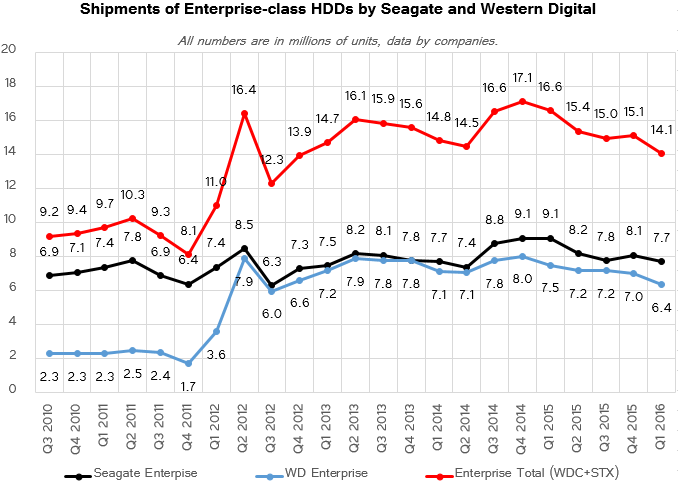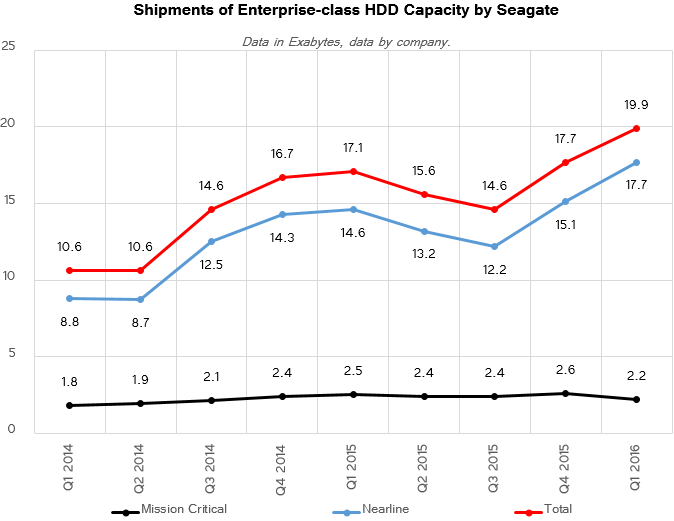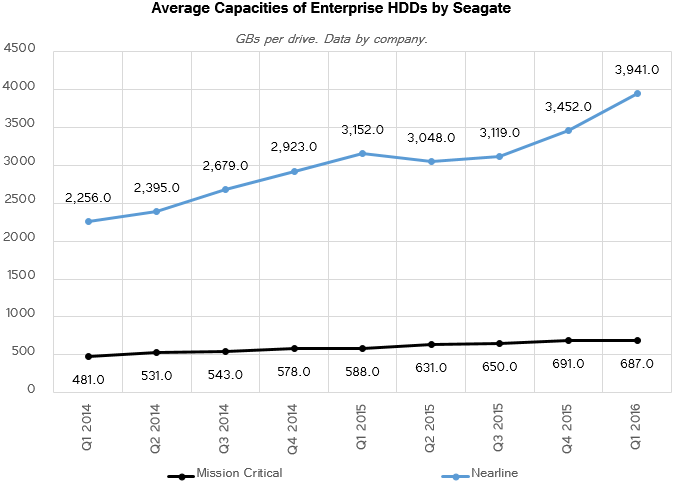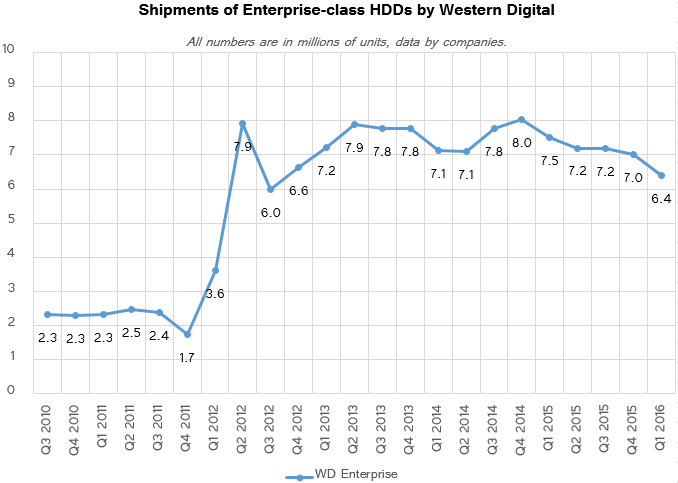Market Views: HDD Shipments Down 20% in Q1 2016, Hit Multi-Year Low
by Anton Shilov on May 12, 2016 8:00 AM ESTUnit Sales of Enterprise HDDs Decline, But There Is a Catch
Enterprise hard disk drives are arguably the most important and lucrative part of HDD makers’ business these days. Firstly, such drives have to use many leading-edge technologies in order to demonstrate very high performance, or offer very high capacities. Secondly, they are not shipped in huge volumes, but they are sold with huge premium because of the technologies as well as extended reliability. Finally, since many client devices no longer have HDDs, but still have to store files elsewhere, their data ends up in the cloud and stored on various datacenter-class HDDs. Basically, even if an HDD maker fails to sell a $50 drive for a low-end laptop, the data from that laptop will eventually be stored on a $300 - $600 nearline drive in a data center, compensating missed revenue to the HDD producer.
There are two types of enterprise-class hard drives:
- High-performance HDDs for mission-critical storage that feature 10K or 15K spindle speeds as well as SAS interface. Such drives compete against SSDs these days and their volumes are slowly declining. This trend has been ongoing for years now and hard drive makers perfectly understand it. Seagate, Toshiba and Western Digital also offer high-end mission critical SSDs with SAS interface to their customers and eventually the portfolio of such solid-state storage devices will only expand.
- Another type of enterprise HDDs are nearline (near online) drives that are used to store various data in data centers. Some of such drives are for cold archives, which are rarely accessed and are hardly ever modified. Such HDDs have 5400 RPM-class spindle speed and their main purpose is to store as much data as possible and at the lowest cost. Other drives are used to store frequently accessed and modified data, which is why they feature 7200 RPM spindle speed and various methods to improve their performance. These drives can be filled with helium to maximize storage space (allowing a reduced platter gap) and keep power consumption down to minimize TCO. Usage of nearline HDDs has been increasing in the recent years. More importantly, their capacities have been growing very rapidly.
It is very important to distinguish between the two types of enterprise-class hard drives not only because they are completely different from a technology point of view, but also because their market dynamics are poles apart. Unfortunately, until this quarter neither of HDD makers disclosed sales of mission critical and nearline drives separately, but only reported the number of enterprise-class HDDs sold. This quarter, Seagate published more or less precise details about its enterprise drives and their dynamics, which we will analyze below. In the meantime, let’s have a look at the shipments of both leading enterprise HDD suppliers.
Based on the numbers from Seagate and Western Digital, sales of enterprise-class hard drives from these two manufacturers declined to 14.09 million units in Q1 2016, which is 15% lower compared to the first quarter last year. Seagate remained the largest supplier of enterprise drives with 7.7 million units sold (down 15.4% YoY), whereas Western Digital supplied 6.39 million of enterprise hard disks (down 15% YoY). Toshiba also has a portfolio of high-end drives for servers, but while it has many products with a SAS interface, it does not participate in the high-end of the nearline market due to lack of 8 TB and 10 TB HDDs in its lineup.
Out of 7.7 million enterprise drives that Seagate shipped in the first quarter, 4.5 million HDDs were for nearline storage applications, whereas 3.2 million HDDs were designed for mission-critical apps.
Shipments of Seagate’s nearline HDDs were down 4.3% compared to the first quarter of 2015, but were slightly up sequentially. The company claims that it expected demand for such drives to be significantly weaker, which is why it could not even satisfy all the demand. During the quarter, Seagate ramped up production of its 8 TB HDD lineup and significantly increased shipments of such drives compared to the previous quarter, however, it could not meet all the demand. The company also supplied a large volume of qualification units of its 10 TB helium-filled hard drives aimed at the highest-end of the cloud market. Due to the 7200 RPM spindle speed and advanced caching sub-system, Seagate’s Enterprise Capacity 3.5 (Helium) 10 TB hard drive is among the fastest in the company’s lineup, challenging even 15K mission-critical drives when it comes to sustained transfer rates (of course, those small drives still have a lot of other advantages, including considerably higher IOPS, significantly lower latency, very high instantaneous transfer rates and so on). In April, the company started revenue shipments of its SATA 10 TB HDDs, which further indicates growing demand for such drives.
By contrast, shipments of mission-critical HDDs dropped 13.6% sequentially and 25.6% year-over-year. The company says that approximately 25% out of 3.2 million mission-critical HDDs are 15K drives, which are gradually replaced by SSDs in the data centers. Solid-state storage devices also challenge 10K HDDs, but the manufacturer expects this segment of the market to have a much longer transition horizon. Because of the economic situation and the market shift to SSDs, sales of mission-critical drives were 700K below Seagate’s original forecast in Q1 2016, the company said.
Given the fact that nearline drives have significantly higher capacities than mission critical drives, it is not surprising that they are driving enterprise storage capacities in terms of EB shipments.
Average enterprise HDD sold by Seagate in Q1 2016 could store 3.941 GB of data, up 25% from the first quarter of last year, which is a direct result of growing demand for capacities from various data center customers.
Western Digital does not break down sales of its enterprise HDDs into nearline and mission critical categories, but while the split may be slightly different, market trends affect both companies in the same way. In its conference call with financial analysts, the management of Western Digital confirmed that shipments of the company’s 15K HDDs are declining because many customers replace such HDDs with SSDs and also observed that many 10K HDD deployments begin to adopt SSDs. In addition, the company noted that in Q1 2016 it saw steeper than expected price declines in performance enterprise and capacity enterprise markets. In particular, the company blamed decreased prices of 4 TB and 8 TB nearline HDDs for its lowering gross margins.















116 Comments
View All Comments
yannigr2 - Thursday, May 12, 2016 - link
I have enough space to not buy a hard disk drive the next 2-3 years. I think I bought my last HDD 2 years ago. Probably this is the case with most people and with SSDs taking the place of boot drives, HDD companies are losing the low capacity market.For most people who build new systems, they wouldn't know what to do with all that space a 240GB SSD will offer them. No second HDD for them, not to mention that a 128GB USB flash drive sometimes will do the trick, if they need to clean up some space from their SSD, without having to call the technician to install the HDD. On the other hand, people who need space will go for one 4TB or bigger drive, probably external, instead of buying more HDDs with lower capacities to put into their PC case.
Old PCs have enough capacity, new PCs go for an SSD or just a single high capacity HDD, instead of many with lower capacity.
Gigantopithecus - Thursday, May 12, 2016 - link
This. Last year I built about 30 desktop computers for typical home users (i.e., office/light productivity, HTPC, and gaming rigs) - three had a spinning hard drive in them. The average user is usually fine with a 250ish GB SSD, and if they run short on room, I tell them to buy a pair of 64GB USB flash drives for $20-30 total.Anton mentions the rise of 4K video as potentially spurring more sales of higher capacity hard drives, but I rarely have anyone ask about how to store even BR-D-quality video, so I'm skeptical that 4K will become a serious driver of increased household storage needs this decade. (At least at the consumer level.)
bill.rookard - Thursday, May 12, 2016 - link
The thing is, even if some small percentage do wind up needing more storage (unlikely), many routers these days do actually offer a USB port for attaching and providing access to a HDD. That means even if they have multiple computers or devices, they don't need more than one large capacity HDD for a single household. Heck, you can get a 4TB Seagate external 2.5" hdd (actually twin 2TB's with a USB -> SATA RAID) for $150 at the local Walmart.The net result in the massive increase in HDD storage capacity along with the rise of the medium capacity (250-500GB) SSD means that your average household has gone from multiple HDDs in their laptops/computers to a single central HDD.
Of course, there are exceptions (I have about 30TB of storage here, but I'm an extreme edge case...) so this will continue to be the trend. Your average storage capacity needs for an entire household are increasing far slower than the average increase in HDD capacity vs price.
JeffFlanagan - Thursday, May 12, 2016 - link
Is 30TB really an extreme edge case? Anyone with a serious video collection will surpass that pretty quickly, and if they're using a DrivePool, they'll use at least 60TB in drive space to store that 30TB.OVerLoRDI - Thursday, May 12, 2016 - link
Or Plex peopleLolimaster - Friday, May 13, 2016 - link
Just a collection of movies, anime (h264/HEVC quality) comics andmanga and you're looking at 30TB's for storage in a matter of a few years.Michael Bay - Monday, May 16, 2016 - link
>using hevc before our Lord and Savior Daiz ordered us toBlasphemer.
Gigaplex - Friday, May 13, 2016 - link
I have a storage array of 9TB usable capacity. Of all the people I know personally, only my brother has a larger storage array. While it's quite easy to get larger than that now, it's definitely not common. So yes, I'd definitely consider 30TB to be an extreme edge case in the grand scheme of things.azazel1024 - Friday, May 13, 2016 - link
Yeah, I have to agree with you Gigaplex. I consider my library to be pretty generous. I probably have something like ~500 movies and maybe 30-40 TV series (granted most are just 1-2 seasons, but some are 5-8), plus some music and pictures (and not JPEGs, but a LOT of RAW images since I am a photographer, even if not a professional). Currently on my 6TB array (5.4TiB formatted) I have 2.86TiB free. I still have some older SD content (or there IS no HD version) where I only have the DVD that I ripped and a lot of my BR collection I only ripped at 720p, but right now I am at about 10% 1080p, 50% 720p and 40% 480p content.I wouldn't consider that a small collection, but I don't need anything like 30 terabytes of storage. Maybe if my entire collection was BDMVs instead of transcoded down files. There gets to be a point though where that is kind of ridiculous to do and is absolutely not "common". Hell, I probably represent 1% of computer users as it is, the ones who have all of their DVDs and BRs in unreduced files are probably 1% of the 1%.
At my rate of growth, I've figured I have about 3-4 more years before I need to worry about storage at all (I don't like having less than ~20% free capacity, or about 1TiB free in this case) and maybe somewhat longer as I do occasionally cull my collection when I realize I haven't watched a movie or something since I bought it years ago, so it gets wiped and I either donate the BR/DVD or I'll just stuff it in a box and forget about it. My collection growth is still positive though, but we are talking maybe 20-40GiB a month (buy a few BRs a month, pictures I've taken, etc.), maybe .5TiB a year.
I doubt it'll happen, but some of me hopes that TLC/3D NAND SSDs are cheap enough by the time I am hitting my self imposed limits just to replace spinning disks in my desktop and server (data is mirrored between them and on 2x3TB RAID0 arrays, plus an external 5TB USB3 disk as a 3rd copy). Probably still too expensive, but I can hope the prices are lower enough and I have the budget to pony up $500-700 to replace the disks in both machines with SSDs (hoping and figuring maybe in 4 years the price of cheap SSDs has dropped under 5 cents per GB). Even if SSD storage is <20%, the beauty there is they are so much faster, no worries about arrays and I can just create a storage pool and add SSDs to it as capacity starts hitting <10% free.
I only have 2Gbps throughput on my network right now (SMB Multichannel, dual 1GbE links). Though I am also hoping in 4 years 2.5GbE or 5GbE networking gear will be on the market...so even SSDs might be a bottleneck on my network some day (but I think I can probably live with that. I'd love multi GB/sec throughputs on my network, but I am barely realistic enough to know I don't actually need it at all, 200+MB/sec is plenty and not worth the cost to try to realize more than 300 or 400MB/sec in the next few years).
Wolfpup - Thursday, July 14, 2016 - link
Oh yeah, RAW images...I wasn't even thinking about that. If you're any kind of remotely serious photographer you'd need gigantic piles of storage too.I remember like early 2000s I had like an 80GB drive in my main system, which was fine. Storage requirements have just absolutely ballooned since then though, while it seems like the rate of drive size increases has massively slowed.